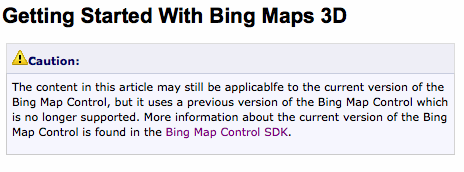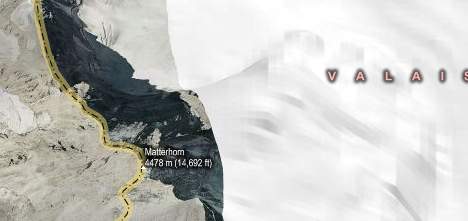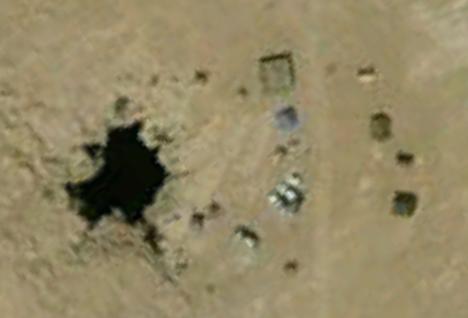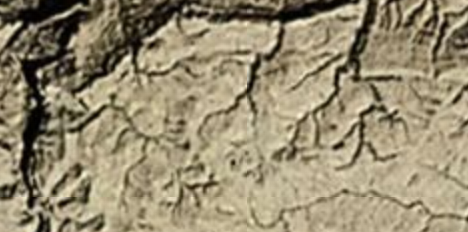Microsoft’s new Bing Maps Beta was released this week, and as Chris Pendleton outlines on his blog, it integrates a range of existing data (satellite imagery, map data, panoramic imagery, PhotoSynth, bird’s eye imagery, photogrammetric data) into a much more seamless web mapping experience, leveraging to the hilt the 3D capabilities of Microsoft’s Silverlight 3 plugin.
Chris doesn’t mention one of the most laudable consequences of the switch to Silverlight — the new Bing Maps Beta works equally well with Macs and PCs. But this comes at an apparent cost that isn’t mentioned either — the old ActiveX-driven Virtual Earth disappears from the new Bing Maps as released this week.
This appears to be confirmed by the caution box now at the top of the article Getting Started with Bing Maps 3D:

(You can still access the old Virtual Earth (on a PC) by exiting the Beta to the old Bing Maps — click the help button on the bottom right of the screen.)
The upshot: While the new Bing Maps now gives you oblique views from quite far out and for all four cardinal points, including of mountainous regions such as the Alps and the Karakorum, the Earth does not start curving as you zoom out. Microsoft’s new Bing Maps 3D is a flat Earth. That’s just as with the 2D Google Maps, of course, but now Microsoft no longer boasts a supported competitor in the virtual globe product space, à la Google Earth web plugin or standalone application.
I’m not lamenting the disappearance of Virtual Earth/Bing Maps 3D. With labels hard-coded into the tiles, rotating the view meant reading names upside down, while its Mac-incompatibility despite being a web app prevented it from becoming a universal resource for referencing a place or view. In the New Bing Maps labels are always right-side up, because either North is up, or because the oblique views of the cardinal points have been prerendered. And the New Bing Maps also takes over some of the features previously found in Virtual Earth, such as the “flying” from one location to another and smooth zooming (of a sort).
Chris Pendleton has hinted that there is much more to come to Bing Maps. Possibly, this means they are working on a virtual globe built with Silverlight, so this may just be an interlude in a long competitive race. Or else, Microsoft may have conceded the fight, reasoning that the bulk of the financially rewarding mapping happens at close zoom and in cities, where Bing Maps is indeed at its strongest. It may have decided that pre-rendered oblique views of much of the Earth at close range is “good enough”.
That would be bad for Google Earth, of course. We want Google Earth developers to live in fear of being bested:-) But at the same time, it cannot possibly be the case that Google Earth is a profit center for Google. Unimaginably valuable PR it is indeed, but not an advertising cash cow. And since Virtual Earth never got the same media kudos as Google Earth for its positive social and educational role, there may be less incentive at Microsoft to compete head to head in this arena.
Since I’m on the topic of Bing Maps, some further points regarding stuff I’ve run into this week as I played with the Beta:
Matterhorn Test: As usual, I checked out my favorite mountain, the Matterhorn, to see how it looks in the new oblique view. Unfortunately, I ran into a data problem. All along the Swiss-Italian border, Italian imagery takes precedence over Swiss imagery, so a thick white strip along Italy’s border sits atop the Matterhorn and the entire Swiss side of the border. Oops.

Global reach: This is an old bugbear of mine, but it is still relevant. Yes, Microsoft adds scores of terrabytes of new data to its maps every month, though most of it is of North America and Europe (and now China). I tend to use maps not for the places I know, but for the places I want to go (or can’t) — Africa, Arabia, Vietnam… I need street data for places like Sana’a and Saigon, where Google delivers but Microsoft not. I can understand Microsoft’s prioritization, and also that I may be an atypical user, but it also means I continue to use Google for my everyday mapping needs.
Case study: I hit upon a blog post about the Majlis al Jinn cave in Oman (with a cavern big enough to fit the Khufu Pyramid), and became intrigued enough to want to find out where it was, and if the sink holes were visible in aerial imagery. A search in Google Earth for “majlis al jinn” returned this:

And a DigitalGlobe image from 2006 that shows individual cars parked next to the entrance:

Google Maps functions in exactly the same way:
But Bing Maps can’t find it, and if I zoom in manually on the place, we get no reference points and 15m base imagery:

I know this is just one anecdotal example, but these are the kinds of comparative experiences I keep on having, and it is here that, for me, Bing Maps needs to improve before it can become a tool I use regularly. No matter how good the display technology, it is the quality, reach and searchability of the underlying content that ultimately adds the most value to my user experiences.
I use Google Earth, but when it comes to imagery in my home country (Maldives) i get more places in high resolution in Bing Maps than Google Earth.
especially the places where Google Earth has low resolution.